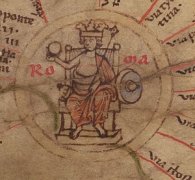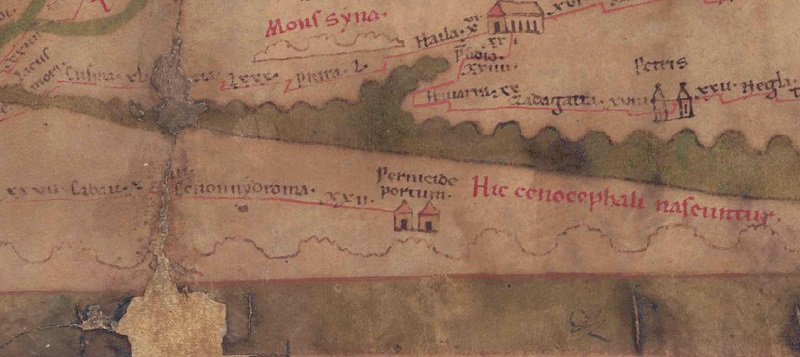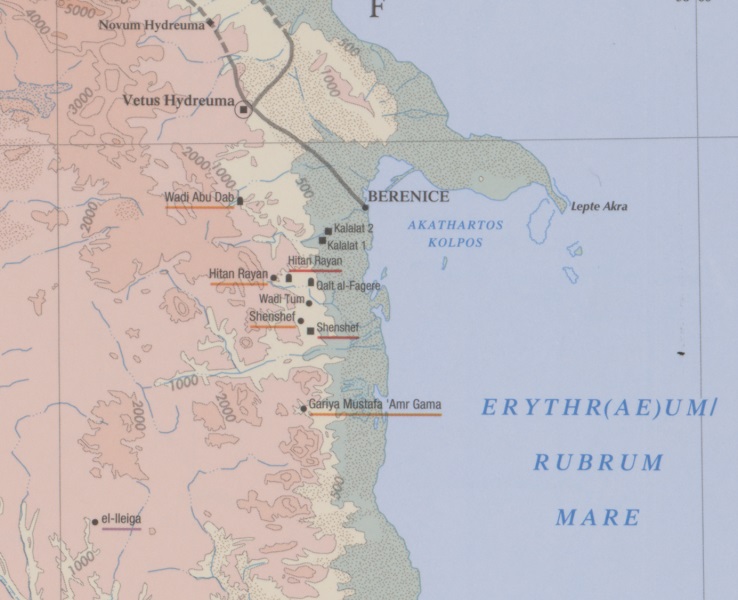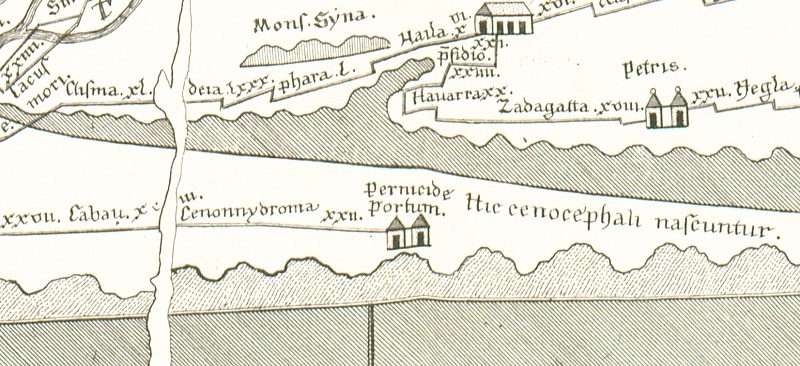
Tabula Peutingeriana – Einzelanzeige
| Toponym TP (aufgelöst): | Pernicide portum |
| Name (modern): | Bender el-Kebir / Medinet el-Haras (Barrington) |
| Bild: |  Zum Bildausschnitt auf der gesamten TP |
| Toponym vorher | XXII Cenonnydroma |
| Toponym nachher | |
| Alternatives Bild | --- |
| Bild (Barrington 2000) |
 |
| Bild (Scheyb 1753) |
 |
| Bild (Welser 1598) | --- |
| Bild (MSI 2025) | --- |
| Pleiades: | https://pleiades.stoa.org/places/785986 |
| Großraum: | Ägypten/Nil/Äthiopien |
| Toponym Typus: | Ortsname mit Symbol |
| Planquadrat: | 8C5 |
| Farbe des Toponyms: | schwarz |
| Vignette Typus : | A Doppelturm |
| Itinerar (ed. Cuntz): | Beronicen (173,4) |
| Inschriften (EDCS-ID): | |
| Alternativer Name (Lexika): | Berenike [9] (DNP) |
| RE: | Berenike |
| Barrington Atlas: | Berenice 80 inset; (81 F2) |
| TIR / TIB /sonstiges: |
|
| Miller: | Pernicide-Portum |
| Levi: | Pernicide-Portum (A,II,2) |
| Ravennat: | Bernitiae (p. 20.04), Berenice (p. 20.20) |
| Ptolemaios (ed. Stückelberger / Grasshoff): | Βερενίκη (4,5,15), Βερενίκη (Βερενίκη ἡ Αἰθιοπικὴ) (8, 15, 19) |
| Plinius: |
|
| Strabo: |
|
| Autor (Hellenismus / Späte Republik): |
|
| Datierung des Toponyms auf der TP: | frühe Kaiserzeit (einschließlich Flavier) |
| Begründung zur Datierung: | In der frühen Kaiserzeit waren Berenike und Myos Hormos die wichtigsten Häfen Ägyptens am Roten Meer, wobei seit der flavischen Zeit möglicherweise Berenike eine größere Bedeutung zuzuschreiben ist. |
| Kommentar zum Toponym: |
Pernicide portum ist identisch mit Berenike Trogodytike. Der von Ptolemaios II. Philadelphos (285-246 v.Chr.) gegründete Hafenplatz am Roten Meer diente neben Myos Hormos dem Import und Export im außermittelmeerischen Warenaustausch (z.B. mit dem indischen Subkontinent) und war als wichtiger Stützpunkt für die Elefantenjagd der Ptolemäerherrscher. Ebenso wie die beiden anderen an der westlichen Rotmeerküste gelegenen Orte Berenike Panchrysos und das direkt am Bab al-Mandab gelegene Berenike Epi Dires liegt der auf der Tabula Peutingeriana als Pernicide portum bezeichnete Ort im Siedlungsgebiet der Trogodyten und wird daher von Plinius als Berenice urbs Troglodytarum (nat. 2, 183) bezeichnet; maximum hic emporium Trogodytarum, etiam Aethiopum „der größte Handelsplatz der Trogodyten und auch der Äthiopier“ sei jedoch Adulis (Plin. 6, 173). Der Namenszusatz Trogodytike verweist auf die geographische Lage des Ortes im Trogodyten-Gebiet (Τρωγοδυτική), das sich an der Ostküste des Roten Meeres von Clysma (Suez) bis zum Bab al-Mandab erstreckte (vgl. Strab. 16, 4, 22 [780]; 17, 1, 1 [785]. 2 [786] = Eratosthenes fr. III B 51 Berger; Diod. 3, 38, 4; Curt. 4, 718; Plin. nat. 2, 178. 185; 6, 164. 167f.; Ptol. 4, 7, 27; Solin. 31, 6). |
| Literatur: |
Kurt Sethe, in: RE III/1, 1897, 280f. s.v. Berenike 5; Miller, Itineraria, Sp. 863; Ronald E. Zitterkopf / Steven E. Sidebotham, Stations and Towers on the Quseir-Nile-Road, in: JEA 75, 1989, 155-189; Steven E. Sidebotham, Historical Sources, in: Ders. / Willemina Z. Wendrich (Hrsg.), Berenike 1994. Report of the 1994 Excavations at Berenike (Egyptian Red Sea Coast) and the Survey of the Eastern Desert, Leiden 1995, 5-11; Steven E. Sidebotham / Ronald E. Zitterkopf, Routes through the Eastern Desert of Egypt, in: Expedition 37/2, 1995, 39-52; Steven E. Sidebotham / Willemina Z. Wendrich (Hrsg.), Berenike 1994. Report of the 1994 Excavations at Berenike (Egyptian Red Sea Coast) and the Survey of the Eastern Desert, Leiden 1995; Steven E. Sidebotham / Willemina Z. Wendrich (Hrsg.), Berenike 1995. Report of the 1995 Excavations at Berenike (Egyptian Red Sea Coast) and the Survey of the Eastern Desert, Leiden 1996; Steven E. Sidebotham / Ronald E. Zitterkopf, Survey of the Via Hadriana by the University of Delaware. The 1996 season, in: BIFAO 97, 1997, 1997, 221-237; Steven E. Sidebotham / Willemina Z. Wendrich (Hrsg.), Berenike 1996. Report of the 1996 Excavations at Berenike (Egyptian Red Sea Coast) and the Survey of the Eastern Desert, Leiden 1998; Richard Talbert, Peutinger’s Roman Map: The Geographical Framework, in: Michael Rathmann (Hrsg.), Wahrnehmung und Erfassung geographischer Räume in der Antike, Mainz 2007, 221-230, hier 228; F. de Romanis, in: TOPOI 14 (2006); Adam Bülow-Jacobsen / Hélène Cuvigny, Sulpicius Serenus, procurator Augusti, et la titulature des préfets de Bérénice, in: Chiron 37, 2007, 11-33; Andrea Jördens, Statthalterliche Verwaltung in der römischen Kaiserzeit. Studien zum praefectus Aegypti, Stuttgart 2009 (= Hist.-E. 175), 424-429; Steven E. Sidebotham, Berenike and the Ancient Maritime Spice Route, Berkeley / Los Angeles 2011, ND 2019 (= The California World History Library 18), 13-16 (Quellenlage). 125-174 mit Table 8-2: Stops/Stations and Distances between Koptos and Berenike (S. 159); Andreina Magioncalda, I prefetti di Berenice, in: Catherine Wolff (Hrsg.), Le métier de soldat dans le monde romain (Actes du cinquième Congrès de Lyon 23-25 sept. 2010), Paris 2012, 461-477; Getzel M. Cohen, The Hellenistic Settlements in the East from Armenia and Mesopotamia to Bactria and India, London 2013, 320-325; Rodney Ast / Roger S. Bagnall, The Receivers of Berenike. New Inscriptions from the 2015 Season, in: Chiron 45 (2015), 171–185; Andrea Jördens, Roman Alexandria, Queen of the Mediterranean and Arabian Seas, in: Nikolas Jaspert / Sebastian Kolditz (Hrsg.), Entre mers - Outre-mer: Spaces, Modes and Agents of Indo-Mediterranean Connectivity, Heidelberg 2018, 77-91, hier 87; Roberta Tomber, Egypt and Eastern Commerce during the Second Century AD and later, in: Andrew Wilson / Alan K. Bowman (Hrsg.), Trade, Commerce, and the State in the Roman World, Oxford 2018 (= Oxford Studies on the Roman Economy), 531-555, hier 537-541; Anna M. Kotarba-Morley, Ancient Port of Trades on the Red Sea Coasts - The ‚Parameters of Attractiveness‘ of Site Locations and Human Adaptations of Fluctuating Land- and Sea-Scapes. Case Study Berenike Troglodytica, Southeastern Egypt, in: Najeeb M.A. Rasul / Ian C.F. Stewart (Hrsg.), Geological Setting, Palaeoenvironment and Archaeology of the Red Sea, Cham 2019, 741-774. |
| Letzte Bearbeitung: | 28.12.2024 17:43 |
Cite this page:
https://www1.ku.de/ggf/ag/tabula_peutingeriana/trefferanzeige.php?id=2835 [zuletzt aufgerufen am 26.12.2025]